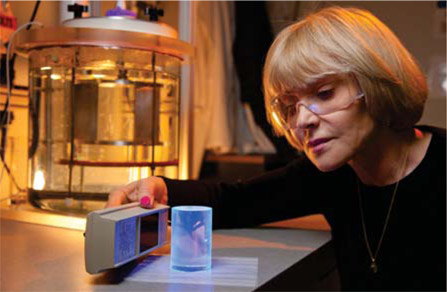New plastic detects weapons materials
DOI: 10.1063/PT.3.1472
Researchers at Lawrence Livermore National Laboratory (LLNL) have developed an inexpensive, nonhazardous plastic for detecting the neutron signatures of nuclear weapons–usable materials. Capable of efficiently distinguishing neutrons from gamma rays, the new polymer scintillator is expected to make practical for the first time handheld radiation detectors for international inspections of uranium enrichment plants and nuclear power reactors. The material could also replace or supplement existing neutron detectors in radiation portal monitors that use scarce helium-3. (See PHYSICS TODAY, May 2011, page 20
Although plastic scintillators have long been used to detect ionizing radiation, until now scientists did not believe it possible to formulate a plastic that could discriminate neutrons from the far more plentiful gamma rays. Unlike 3He detectors, which pick up thermal, or low-energy, neutrons, the polymer developed at LLNL scintillates with high-energy neutrons, the type emitted by the fissile isotopes uranium-235 and plutonium-239. David Beach, program manager for special nuclear materials movement, radiation detection, and advanced materials at the National Nuclear Security Administration, says those fast neutrons can “punch through” significant amounts of shielding and are detectable up to tens of meters away from their source. Moreover, since the background level for fast neutrons is two orders of magnitude lower than that of thermal neutrons, detecting just a few fast ones, Beach notes, is sufficient to indicate the presence of weapons-usable materials.
Eljen Technology, which manufactures organic scintillators and has produced samples of the plastic for LLNL, is now working to scale up the manufacturing process. An LLNL spokesman says Eljen, located in Sweetwater, Texas, is in licensing negotiations, and two other companies have also expressed interest in licensing the technology.
According to Beach, portal monitors containing the new material could be ready for testing within two years, with handheld detectors to follow. Natalia Zaitseva, the principal investigator on the LLNL team, is confident that the material will also find broad applications in neutron imaging and other scientific applications. “For scientific experiments, it will definitely replace all liquid scintillators,” she predicts.
Zaitseva says that scientists who work with neutrons have been contacting her ever since the research was published online in December in the journal Nuclear Instruments and Methods in Physics Research A. The paper details how the LLNL team developed a polyvinyl toluene polymer matrix loaded with a scintillating dye, 2,5-diphenyloxazole (PPO). The research team describes how the relative ease of fabrication and the deployment advantages of the plastic compared to liquid scintillators make it suited for use in “large-volume and low-cost neutron detectors.”
“The most important part of our work is to show that plastics are capable of doing this,” says Zaitseva. For scintillation to occur, she explains, neutrons must interact with two PPO molecules in the plastic’s matrix. The team achieved the right distance between the two molecules for scintillation by iteratively increasing the concentration of PPO until the threshold was reached. Zaitseva’s team is now striving to develop a plastic that will detect thermal neutrons, the kind that are picked up by the 3He tubes in most portal monitors now in use.

Natalia Zaitseva examines the new plastic developed at Lawrence Livermore National Laboratory. The instrument she holds produces UV light that causes the material to glow blue.

More about the Authors
David Kramer. dkramer@aip.org




